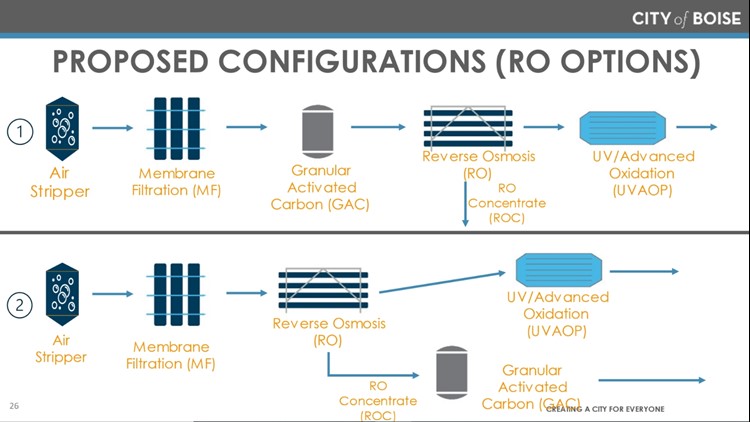BOISE, Idaho — This article originally appeared in the Idaho Press.
For years, Boise residents have told the city that they want investments in clean wastewater technology and water conservation.
In January, the City of Boise will launch a pilot program to identify the best way to clean industrial wastewater, recycling it for additional uses. It is the first project to come out of the city’s Water Renewal Utility Plan, approved by the city council in October 2020 following opportunities for public input, including a public hearing, said Haley Falconer, senior manager of the city’s environmental division.
“We heard pretty consistently from the community that it was important that we found better ways to use that water, that we keep our water local and we put it to good use,” Falconer said.
The water being processed through the pilot program will not contain any human excrement, urine, viruses, or other waste disposed of through household toilets, sinks, or showers, Falconer said. Water used for the pilot will come from a Micron facility in southeast Boise. The city is planning to build a water renewal facility in that part of the city that will treat industrial wastewater and “grow with other industrial or commercial sources in that part of town,” Falconer said. The city will be asking the public for feedback on that design down the road, said Natalie Monro, public works spokesperson for the city.
The city hopes to run the pilot program for at least a year, Falconer said. Eventually, the city will also pilot uses for the recycled water.
Methods of water treatment:
Manufacturing and other industrial operations often require water for a variety of purposes. In the process, water can pick up chemicals and other contaminants. In the water treatment world, these are referred to as constituents, or constituents of interest if they are materials that are not currently regulated but might be in the future.
The project in Boise will test five technologies to see which are best at removing different types of constituents from the water. It’s kind of like a puzzle: city personnel want to know in which order to use different technologies and whether it is possible to clean the water just as well when leaving out a process or two, Monro said.
One of the technologies, an air scrubber, pumps air into the water, removing chemicals with the tendency to evaporate, Monro said. In a second technology, water is allowed to filter through a membrane with openings narrower than a hair, Falconer said. A third technology uses reverse osmosis to push water through a membrane, taking dissolved salts out of the water, Monro said. The fourth technology involves pouring the water over granular activated carbon, which can pull chemicals out of the water, similar to a home water filtration system, Monro said. Last, the fifth technology uses ultraviolet advanced oxidation to destabilize any DNA in the water, followed by adding peroxide to oxidize organic matter, Falconer said. Often, this precedes the water going through an activated carbon system, she said.
The city will prioritize removing PFAS from wastewater, Falconer said. PFAS represents a class of thousands of chemicals used to make a variety of goods, including nonstick pans and cosmetics, according to reporting from National Public Radio. These chemicals made headlines in recent months for being flagged by the U.S. Environmental Protection Agency as potentially unsafe in drinking water even in small quantities, the NPR report said.
Testing all of these complex systems gives city personnel a chance to learn how each work, what is most effective, and to develop design criteria for how the technology would be used at a large scale in the future facility, Falconer said.
All of the technologies in Boise’s pilot are used elsewhere for water purification, Monro said. The city has consulted with a team of experts from areas with dry and hot climates, such as southern California and Texas.
Potential uses:
The city is also thinking about how to use the recycled water generated by the facility in the future. One idea is returning the water to industrial water users for reuse.
“It’s to offset the water that they would be taking,” Falconer said, “so rather than having them pull that water from groundwater, the river, or wherever … we will be a new source of water for them so that water would stay available for the community.”
Another option is putting the treated water back into the groundwater table, Monro said. The city plans to launch an additional pilot that would look at different sites where this could occur, testing soil characteristics and other factors, and then experimenting with how to put the recycled water in the ground at those sites, she said.
Currently, the city is hoping to clean the water to a drinkable level, but it is not considering an option to reuse the water as a source of drinking water, Monro said.
Opportunity for future public input:
The city plans to hold a public hearing meeting once the pilot has been going for a while where the public can receive updates and offer additional input.
The public will be able to ask questions and provide comments that will be taken under consideration, Monro said.
“This has been a project that has had a lot of community engagement and will continue to have community engagement,” she said.
This article originally appeared in the Idaho Press, read more on IdahoPress.com.
Watch more Local News:
See the latest news from around the Treasure Valley and the Gem State in our YouTube playlist:



